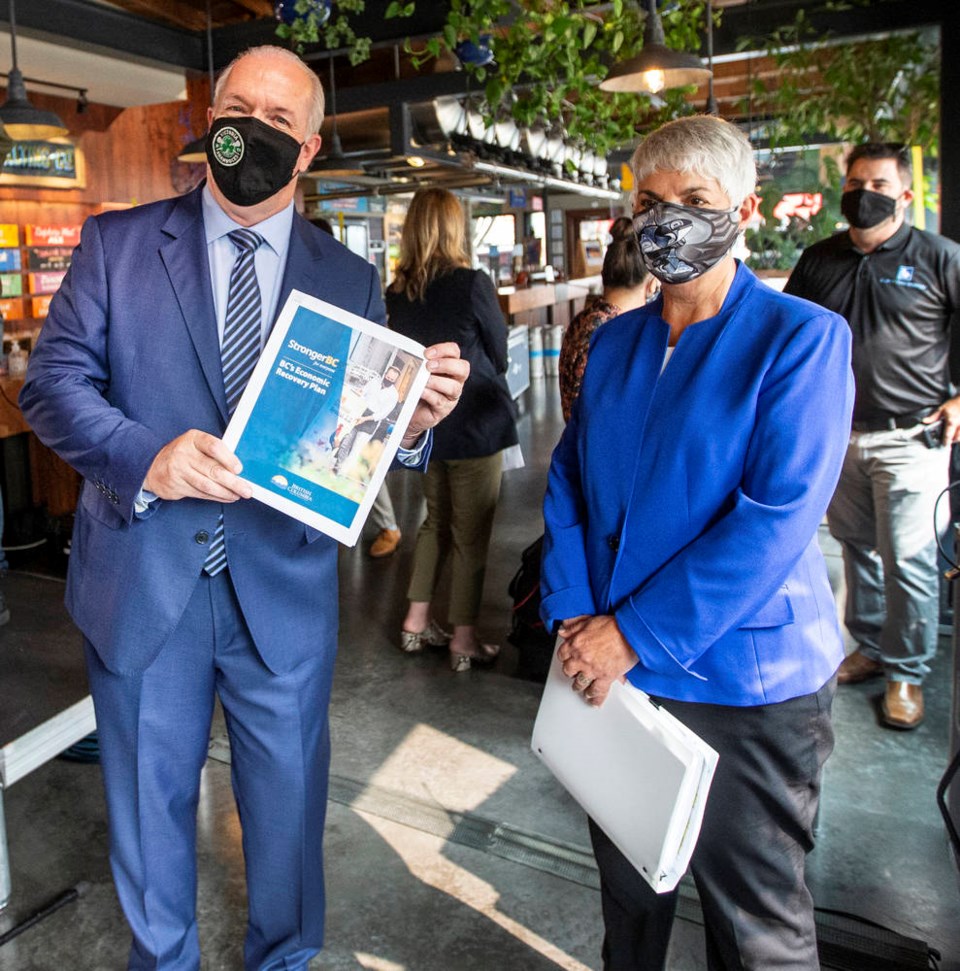It took six months for the NDP government to release the economic recovery part of B.C.’s ongoing COVID-19 response. That’s a long time, given that the government committed about $5 billion in no time flat on various emergency relief measures.
The reason for the delay became clearer Thursday upon its release. Sometime between March and now, the NDP brain trust realized they could capitalize on the unity of purpose that provincial health officer Dr. Bonnie Henry and Health Minister Adrian Dix were creating.
So that $1.5-billion recovery package took on a dual purpose. It became an election-campaign platform, too. The NDP has decided to get as much benefit out of it politically as all the potential recipients are expecting economically.
It rolled out Thursday as a big, complicated series of new and re-announced goodie bags. It’s confusing to separate what’s new money and what’s already been earmarked, if not spent.
The main communication goal seems to have been: “Make the numbers as big as possible, to show how much we’re doing.”
Billions of dollars are now in play for various worthy purposes. But the other purpose won’t be confirmed until the expected election call is made.
Premier John Horgan said during the unveiling that he hasn’t decided yet. But you just have to glance at the thing to realize it’s game on.
Bureaucrats were ordered to stuff so much into it they misplaced one big number and had to reissue it. That almost never happens. Previous updates on COVID-19’s economic impact were all charts and graphs in plain text. This one is 34 pages plus lots more background documents, and is printed in full colour. It has 15 pictures of happy recovering workers and happy recovering families. Even the people wearing masks look happy.
Put it up on a screen next to the NDP 2017 election platform and it looks very similar, right down to the party colour.
Horgan chewed a lot of scenery in introducing the plan. “Six months ago, the unthinkable happened … global shutdown … sad consequences and ramifications on every corner of the planet. … We came together and marshalled historic resources.”
In his telling, it’s the age-old tale of a hero faced with sudden adversity who rises to the challenge. The final chapter hasn’t been written, but he’s obviously looking for a triumphant ending.
Even if that involves abandoning all that “esprit de corps and collaboration by all members of the house” and jamming an election into the middle of an expected fall surge in the pandemic in the midst of the highest case counts since it started.
The technical aspects of the funding are unique. It was all approved by the legislature in March, when everyone was seized by that urgent sense of mission. There were almost no partisan arguments.
Governments are usually constrained by the need to balance budgets. But that brake was taken off months ago. The deficit is so high now that a balanced budget is a faint memory.
Officials said on background that much of the recovery spending “is largely short-term or one-time funding that responds to immediate needs.”
That was driven by consultation with taxpayers, but it also fits with the political goal of opening the treasury as wide as possible prior to any vote.
Finance Minister Carole James said the various programs are all new. “This is all new spending, all been approved and ready to go out the door.”
So the blitz is on. Look for thousands more health workers, youth working in parks, still more bike paths, agritech funding, “underperforming forest” work, shoreline cleanup efforts, “micro-credentialing” (certification for specific tasks in new jobs) and many more. There’s even $2 million for a “building confidence app.” (It’s for tourists, not voters.)
People can start planning for new tax breaks (worth $660 million over two years) and there are a number of new grant programs that will be open for business in double-quick time.
“Stronger B.C. For Everyone,” as it’s dubbed, also includes a $270 million commitment to local governments, matched by Ottawa. That’s a nice thing to walk into the Union of B.C. Municipalities’ convention with next week. The virtual equivalent of a standing ovation that you’d get there for giving that kind of money away could give a man ideas, if he doesn’t have them already.



